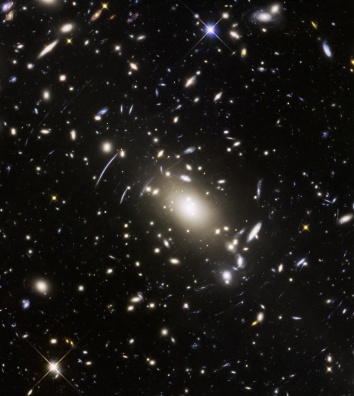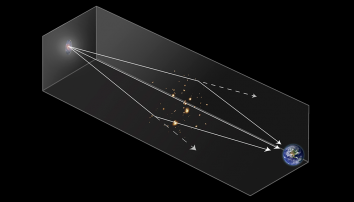
John Chisholm, assistant professor of astronomy at The University of Texas at Austin and co-principal investigator on the selected proposal.
19 July 2023
BY EMILY HOWARD
The James Webb Space Telescope (JWST) has awarded 148 hours of observing time to a group of scientists led by John Chisholm, assistant professor of astronomy at The University of Texas at Austin. He is co-principal investigator on the selected proposal, along with Hakim Atek at the Institut D'Astrophysique de Paris. “That’s over six days on the telescope,” says Chisholm. And only one hour less than the proposal that was awarded the most amount of time.
Getting time on JWST is very competitive. Astronomers around the world submit proposals for what they would like to observe with the telescope and for how much time. For its second year of observations, JWST received 1,601 proposals. Of those the size of Chisholm’s, only one in seven were approved.
“I am honored and excited that our proposal was selected,” says Chisholm. “Now we are waiting for the telescope to start observing the part of the sky we are interested in, likely next spring.”
Chisholm and his team plan to:
“The faint galaxies that we are targeting have never been observed before, but they are expected to be the building blocks of more massive galaxies at later times,” explains Chisholm. “How many galaxies there are will reveal crucial information on the presence of dark matter; how the first galaxies formed stars and built up their masses; and basic properties of our Universe.”
How They’ll View Early Galaxies
Chisholm’s team will rely on an astronomical effect called “gravitational lensing” to view galaxies present in the early Universe. Gravitational lensing occurs when a supermassive object, like a cluster of galaxies, warps the gravitational field around itself. When light travels through the gravitational field, it is distorted, bent around the supermassive object, and made to look larger and brighter than it would otherwise.
When astronomers look at the area around the supermassive object, where gravitational lensing is occurring, it’s like looking through a magnifying glass to see the smaller, more distant objects in the background. Thanks to this lensing effect, astronomers are able to study early galaxies that would otherwise be too faint and distant to see with current technology.
Using JWST to Study the Early Universe
Chisholm’s team will observe the gravitational lensing occurring around the supermassive galaxy cluster Abell S1063.
Though this area has been studied with other telescopes, JWST will be able to view it with unprecedented precision and depth. This is thanks to several features. For one, JWST has a large, 6.5-meter (23.1-foot) mirror, which is able to collect more of the light emitted from faint, distant objects. This allows astronomers to detect hard-to-find objects and view them clearly.
JWST is also able to view objects in infrared wavelengths, which is particularly important when studying the early Universe. As the Universe expands, light emitted by stars in shorter ultraviolet and visible wavelengths stretches into the longer wavelengths of infrared light. This means the light from objects present in the early Universe is very stretched, and only visible to instruments that can capture infrared wavelengths.
“Our goal is to obtain a view of the faintest galaxies in the early Universe,” says Chisholm. “These observations will likely be the deepest that JWST will ever be able to take.” Using gravitational lensing, paired with JWST’s impressive capabilities, Chisholm’s team will capture the earliest glimpse of our Universe yet detected.
JWST’s second year of observations starts in July 2023. Chisholm and his team expect the telescope to be able to start monitoring the area around Abell S1063 in May 2024.
Acknowledgements
The James Webb Space Telescope (JWST) is the world’s leading observatory for space exploration. JWST is an international program led by NASA with its partners, ESA (European Space Agency) and CSA (Canadian Space Agency).
The title of the awarded proposal is "JWST's GLIMPSE: gravitational lensing & NIRCam imaging to probe early galaxy formation and sources of reionization." Its investigators include: Hakim Atek (CoPI), Institut d'Astrophysique de Paris; John Chisholm (CoPI), The University of Texas at Austin; Johan Pierre Richard, Centre de Recherche Astrophysique de Lyon; Iryna Chemerynska, Institut d'Astrophysique de Paris; Pascal Oesch, University of Geneva, Department of Astronomy; Jean-Paul Richard Kneib, Ecole Polytechnique Federale de Lausanne; Danielle Berg, The University of Texas at Austin; Marta Volonteri, Institut d'Astrophysique de Paris; Floriane Leclercq, The University of Texas at Austin; Ryan Endsley, The University of Texas at Austin; Rui Marques-Chaves, University of Geneva, Department of Astronomy; Charlotte Mason, University of Copenhagen, Niels Bohr Institute; Rychard Bouwens, Universiteit Leiden; Lukas Jonathan Furtak, Ben-Gurion University of the Negev; Maxime Trebitsch, University of Groningen; Rohan Naidu, Massachusetts Institute of Technology; Alberto Saldana Lopez, University of Geneva, Department of Astronomy; Daniel P. Stark, University of Arizona; Miroslava Dessauges-Zavadsky, University of Geneva, Department of Astronomy; Ivo Labbe, Swinburne University of Technology; Rachel Bezanson, University of Pittsburgh; Joakim Rosdahl, Centre de Recherche Astrophysique de Lyon; Jeremy Blaizot, Centre de Recherche Astrophysique de Lyon; Daniel Schaerer, University of Geneva, Department of Astronomy; Priya Natarajan, Yale University; Anahita Alavi, California Institute of Technology.
- END –
Media Contact:
Emily Howard
Communications Manager, McDonald Observatory
emily.howard@austin.utexas.edu
512-475-6763

John Chisholm, assistant professor of astronomy at The University of Texas at Austin and co-principal investigator on the selected proposal.

Galaxy cluster Abell S1063. The tremendous mass of the cluster acts as a cosmic magnifying glass, enlarging even more distant galaxies so they become bright enough for telescopes to see. The many arcs and streaks in the picture are stretched images of background galaxies. Chisholm and his team will use this effect, called “gravitational lensing,” and the JWST to observe distant galaxies as they appeared in the early Universe. Credit: NASA, ESA, and J. Lotz (STScI).

This diagram illustrates how rays of light from a distant galaxy or star can be bent by the gravity of an intervening galaxy cluster. As a result, an observer on Earth sees the distant object appear brighter than it would look if it weren't gravitationally lensed. Credit: NASA, ESA, Ann Feild (STScI), Frank Summers (STScI).